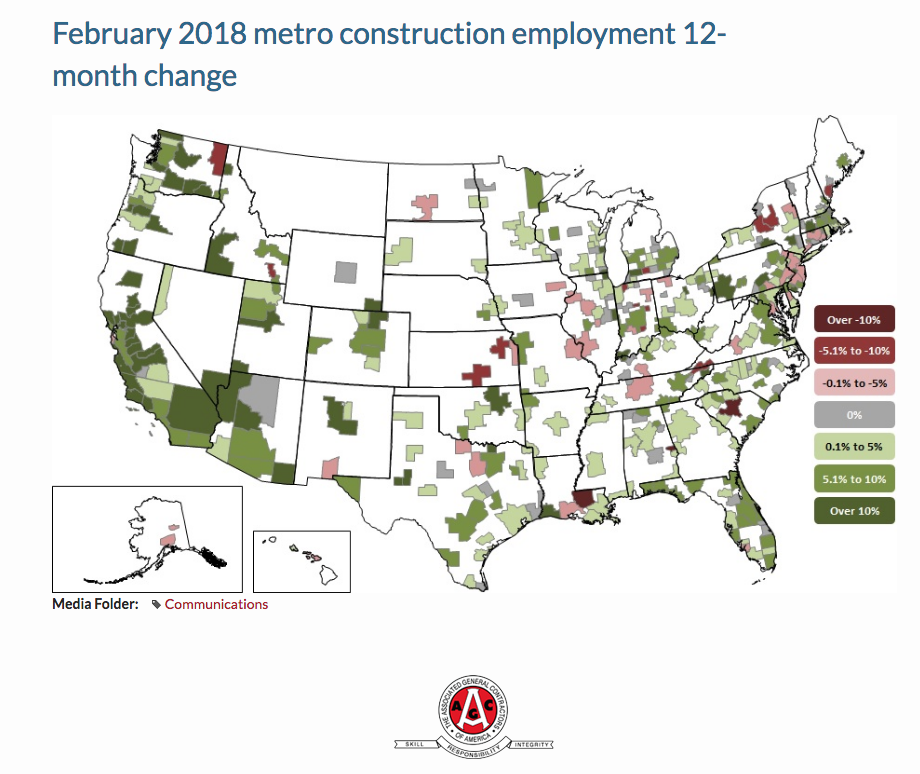Construction employment increased in 257 out of 358 metro areas between February 2017 and February 2018
High market demand spurs hiring but builders face ongoing worker shortage.
- Riverside-San Bernardino-Ontario, Calif. and Merced, Calif. Experience Largest Year-over-Year Gains;
- Baton Rouge, La. and Auburn-Opelika, Ala. Have Biggest Annual Declines in Construction Employment

Construction employment increased in 257 out of 358 metro areas between February 2017 and February 2018, declined in 50 and stagnated in 51, according to a new analysis of federal employment data released today by the Associated General Contractors of America. Association officials said that the employment gains are occurring as construction firms in many parts of the country are having a hard time finding enough qualified workers to keep pace with demand.
"Growing private-sector demand for construction services is prompting construction firms to hire more people to complete projects," said Ken Simonson, the association's chief economist. "Yet tight labor markets, particularly for qualified construction workers, is making it increasingly difficult for firms to find people to bring on board."
Riverside-San Bernardino-Ontario, Calif. added the most construction jobs during the past year (12,000 jobs, 13 percent), followed by Phoenix-Mesa-Scottsdale, Ariz. (9,900 jobs, 9 percent); Dallas-Plano-Irving, Texas (9,700 jobs, 7 percent); Houston-The Woodlands-Sugar Land, Texas (9,300 jobs, 4 percent) and Los Angeles-Long Beach-Glendale, Calif. (7,700 jobs, 6 percent). The largest percentage gains occurred in the Merced, Calif. metro area (33 percent, 700 jobs) followed by Midland, Texas (22 percent, 5,400 jobs); Lake Charles, La. (21 percent, 4,700 jobs) and Weirton-Steubenville, W.V.-Ohio (21 percent, 300 jobs).
The largest job losses from February 2017 to February 2018 were in Baton Rouge, La. (-6,500 jobs, -12 percent), followed by St. Louis, Mo.-Ill. (-2,500 jobs, -4 percent); Columbia, S.C. (-2,200 jobs, -11 percent); Fort Worth-Arlington, Texas (-2,000 jobs, -3 percent) and Middlesex-Monmouth-Ocean, N.J. (-1,700 jobs, -5 percent). The largest percentage decreases for the year were in Auburn-Opelika, Ala. (-38 percent, -1,500 jobs) followed by Baton Rouge, Columbia, S.C. and Kokomo, Ind. (-9 percent, -100 jobs).
Association officials said that growing private sector demand in February is prompting many firms to add more staff as they work to complete projects. They added that the recently-enacted federal spending measure includes up to $10 billion in additional infrastructure funding for this year, meaning firms that perform public-sector work are likely to begin expanding as well amid tight labor market conditions.
"As demand for construction continues to expand, it will only get harder for many firms to find qualified workers to hire," said Stephen E. Sandherr, the association's chief executive officer. "Congress and the administration should work together to expand career and technical education opportunities so more high school students will opt for good-paying careers in construction."
View the metro employment data by rank and state. View metro employment map.
















